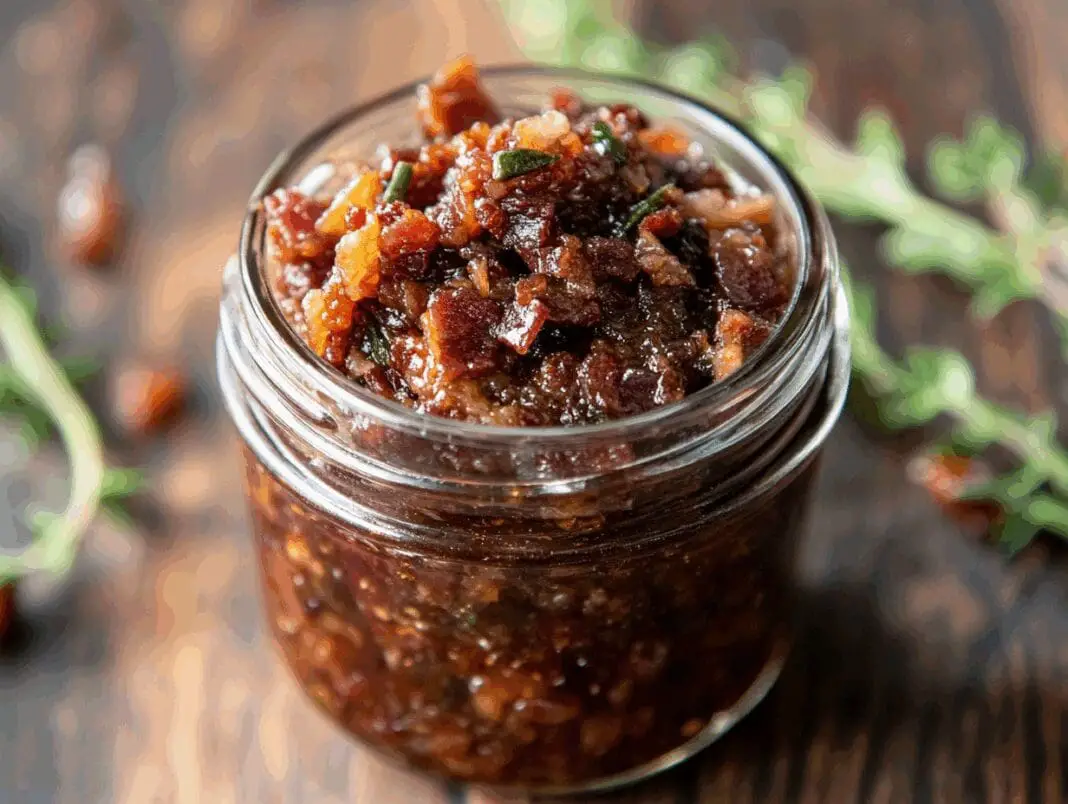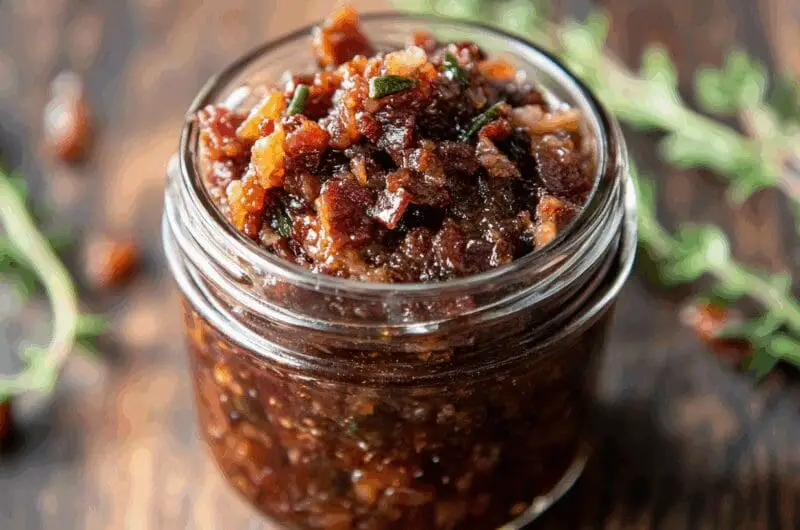Most people think bacon jam is just crispy bacon mixed with sugar, but that approach leads to disappointment every single time. The secret lies in slow-cooking thick-cut bacon until it reaches that perfect balance between crispy edges and tender centers, then building layers of sweet and tangy elements that complement rather than overpower the smoky pork. This isn’t your average breakfast spread – it’s a game-changing condiment that transforms everything from morning toast to gourmet burgers into something truly special.
Be careful not to overcook the bacon
The biggest mistake home cooks make is treating bacon jam like regular bacon cooking. High heat might work for breakfast strips, but jam requires patience and lower temperatures. Start with thick-cut bacon in a cold pan, allowing the fat to render slowly over medium-low heat. This process takes about 15-20 minutes, but rushing it creates tough, chewy pieces that ruin the entire batch.
Watch for bacon that’s golden brown but still has some flexibility – not the brittle crispiness most people associate with perfect bacon. The rendered fat becomes part of the jam’s base, so every drop counts. Remove the bacon pieces but keep that liquid gold in the pan for the next steps. This technique ensures tender bacon pieces that hold together during the long cooking process.
Sugar isn’t the only sweetener that works
Brown sugar adds molasses notes that complement bacon’s smokiness, but maple syrup creates an even more complex profile. Real maple syrup brings subtle vanilla and caramel undertones that artificial versions simply cannot match. Start with half brown sugar and half maple syrup for the perfect balance. Honey works too, though it tends to crystallize during storage and changes the jam’s texture.
Coffee adds unexpected depth without making the jam taste like breakfast. Just two tablespoons of strong black coffee enhance the bacon’s smokiness while cutting through the sweetness. Some recipes call for bourbon or whiskey, but alcohol can make the jam too thin unless properly reduced. Stick with coffee for consistent results that work with both sweet and savory applications.
The onions matter more than you think
Sweet onions like Vidalia or Walla Walla provide the best base for bacon jam, but yellow onions work in a pinch. Slice them thin and cook them in the bacon fat until they’re deeply caramelized – this takes at least 30 minutes of stirring and patience. Properly caramelized onions turn golden brown and develop natural sweetness that balances the bacon’s saltiness perfectly.
Red onions add beautiful color but can become bitter during long cooking times. Shallots offer delicate sweetness but cost significantly more than regular onions. The key is cooking them low and slow until they practically melt into the mixture. Caramelized onions should never taste sharp or acidic – that means they need more time in the pan.
Vinegar choice affects the final taste
Apple cider vinegar provides the perfect acidity level without overwhelming the other ingredients. White vinegar tastes too harsh, while balsamic vinegar adds unnecessary complexity and darkens the jam’s appearance. The vinegar’s job is cutting through richness and adding brightness – not competing with the bacon and onions for attention. Two tablespoons usually does the trick for most batches.
Rice vinegar works well too, offering gentler acidity that won’t shock sensitive palates. Some cooks swear by sherry vinegar for its nutty undertones, but it can be hard to find in regular grocery stores. The timing matters as much as the type – add vinegar during the last few minutes of cooking to preserve its bright notes. Adding it too early causes the acidity to cook off completely.
Timing the cooking process takes practice
The entire cooking process takes about 45 minutes to an hour, but watching for visual cues matters more than following strict time limits. The mixture should bubble gently throughout cooking – vigorous boiling evaporates too much liquid and burns the sugars. Stir every few minutes to prevent sticking, especially during the final stages when the jam thickens considerably.
The jam is ready when it coats the back of a spoon and holds its shape when stirred. It will continue thickening as it cools, so slightly underdone is better than overdone. Testing jam consistency can be tricky for beginners, but the spoon test rarely fails. If the jam slides off immediately, it needs more cooking time.
Storage mistakes ruin perfectly good batches
Hot bacon jam must cool completely before refrigeration, or condensation will water down the consistency and promote bacterial growth. Use glass jars rather than plastic containers – the acidity can react with some plastics and create off-putting chemical tastes. Mason jars work perfectly and allow easy portion control for different uses throughout the week.
Properly stored bacon jam lasts up to three weeks in the refrigerator, though most batches disappear much faster. The high salt and acid content act as natural preservatives, but always check for mold before using. Food safety guidelines recommend using within two weeks for maximum freshness. Freezing works too, though the texture becomes slightly grainier after thawing.
Pairing bacon jam requires some thought
Cream cheese and bacon jam on everything bagels creates an instant crowd-pleaser that beats any expensive brunch restaurant. The combination works because cream cheese’s mildness lets the jam’s complex sweetness shine through. Sourdough toast provides the perfect tangy backdrop, while brioche adds buttery richness that complements the bacon fat beautifully.
Grilled cheese sandwiches reach new heights with bacon jam spread on the inside before cooking. The jam caramelizes slightly from the heat, creating incredible depth that regular bacon strips cannot match. Classic grilled cheese becomes gourmet with just a tablespoon of this magical spread. Burgers, pizza, and even ice cream benefit from bacon jam’s sweet-savory balance.
Making large batches saves time and money
Double or triple recipes work just as well as single batches, but cooking times increase slightly due to larger volumes. Use a wider pan to maintain proper evaporation rates – overcrowding leads to steaming instead of proper caramelization. The extra effort pays off when gift-giving season arrives, as homemade bacon jam makes impressive presents that cost less than store-bought gourmet spreads.
Buy bacon in bulk when it goes on sale, since it freezes well before cooking. Thick-cut varieties often cost less per pound than thin-cut options, and they work better for jam anyway. Freezing bacon properly means always having jam ingredients on hand. Large batches also allow experimentation with different spice combinations without wasting small amounts of expensive ingredients.
This bacon jam recipe transforms simple ingredients into something extraordinary through patience and proper technique. The sweet and savory combination works with everything from breakfast toast to gourmet dinner applications, making it one of the most versatile condiments any home cook can master. Start with quality ingredients, take time with each step, and prepare for requests from everyone who tries it.
Heavenly Bacon Jam
Course: CondimentCuisine: American8
servings15
minutes1
hour85
kcalSweet and savory bacon jam that transforms ordinary meals into extraordinary experiences with its perfect balance of smoky, caramelized goodness.
Ingredients
1 pound thick-cut bacon, chopped into 1/2-inch pieces
2 large sweet onions (Vidalia or Walla Walla), thinly sliced
1/4 cup brown sugar, packed
1/4 cup pure maple syrup
2 tablespoons apple cider vinegar
2 tablespoons strong black coffee, cooled
1/4 teaspoon black pepper, freshly ground
1/8 teaspoon red pepper flakes (optional)
1 tablespoon fresh thyme leaves (optional)
Directions
- Place chopped bacon in a large, cold skillet or heavy-bottomed pan. Cook over medium-low heat, stirring occasionally, until the bacon renders its fat and becomes golden brown but still slightly flexible, about 15-20 minutes. Do not rush this process as high heat will make the bacon tough and chewy.
- Remove the cooked bacon pieces with a slotted spoon and set aside on a paper towel-lined plate. Leave approximately 3-4 tablespoons of bacon fat in the pan – this will be the base for caramelizing the onions. If there’s excess fat, pour it off but save it for other cooking uses.
- Add the thinly sliced onions to the bacon fat in the same pan. Cook over medium-low heat, stirring frequently, until the onions become deeply caramelized and golden brown, about 25-30 minutes. The onions should be soft, sweet, and jammy in texture – this step is crucial for developing the jam’s complex sweetness.
- Return the cooked bacon to the pan with the caramelized onions. Add the brown sugar and maple syrup, stirring to combine evenly. The mixture will bubble and foam initially – this is normal as the sugars begin to caramelize with the rendered fat.
- Add the black coffee, black pepper, and red pepper flakes if using. Reduce heat to low and simmer gently for 15-20 minutes, stirring every few minutes to prevent sticking. The mixture should bubble gently but never boil vigorously, as this will burn the sugars and create a bitter taste.
- Stir in the apple cider vinegar during the last 3-4 minutes of cooking to preserve its bright acidity. The jam is ready when it coats the back of a spoon and holds its shape when stirred. It will continue to thicken as it cools, so slightly underdone is better than overdone.
- Remove from heat and stir in fresh thyme leaves if using. Allow the bacon jam to cool completely in the pan before transferring to storage containers. The cooling process takes about 30 minutes and is essential for achieving the proper final consistency.
- Transfer the cooled bacon jam to clean glass jars or airtight containers. Store in the refrigerator for up to 3 weeks, though it’s best used within 2 weeks for optimal freshness. Bring to room temperature before serving for the best spreadable consistency.
Notes
- Thick-cut bacon works best as it holds its shape better during the long cooking process and provides more substantial pieces in the final jam.
- Don’t skip the coffee – it adds incredible depth without making the jam taste like coffee, and helps balance the sweetness perfectly.
- The jam can be frozen for up to 3 months, though the texture becomes slightly grainier after thawing – still delicious but best used in cooked applications.
Frequently Asked Questions About Bacon Jam
Q: Can I use regular bacon instead of thick-cut bacon for this recipe?
A: While you can use regular bacon, thick-cut works much better because it holds its shape during the long cooking process and provides more substantial pieces in the final jam. Regular bacon tends to break apart and become too crispy, creating an unpleasant texture. If you only have regular bacon, reduce the cooking time slightly and watch carefully to prevent overcooking.
Q: How long does homemade bacon jam last in the refrigerator?
A: Properly stored bacon jam lasts up to 3 weeks in the refrigerator when kept in clean glass jars or airtight containers. However, it’s best used within 2 weeks for optimal freshness and flavor. The high salt and acid content act as natural preservatives, but always check for any signs of mold before using and trust your senses.
Q: What’s the best way to tell when the bacon jam is finished cooking?
A: The jam is ready when it coats the back of a spoon and holds its shape when you stir it – similar to testing regular fruit jams. It should have a glossy, thick consistency that doesn’t slide off the spoon immediately. Remember that it will continue to thicken as it cools, so slightly underdone is better than overdone to avoid a gummy texture.
Q: Can I make bacon jam without the coffee, and what does it add to the recipe?
A: You can skip the coffee, but it adds incredible depth and complexity without making the jam taste like coffee. The coffee enhances the bacon’s smokiness while cutting through the sweetness, creating a more balanced final product. If you prefer to omit it, consider adding an extra tablespoon of apple cider vinegar to maintain the proper acidity balance.


